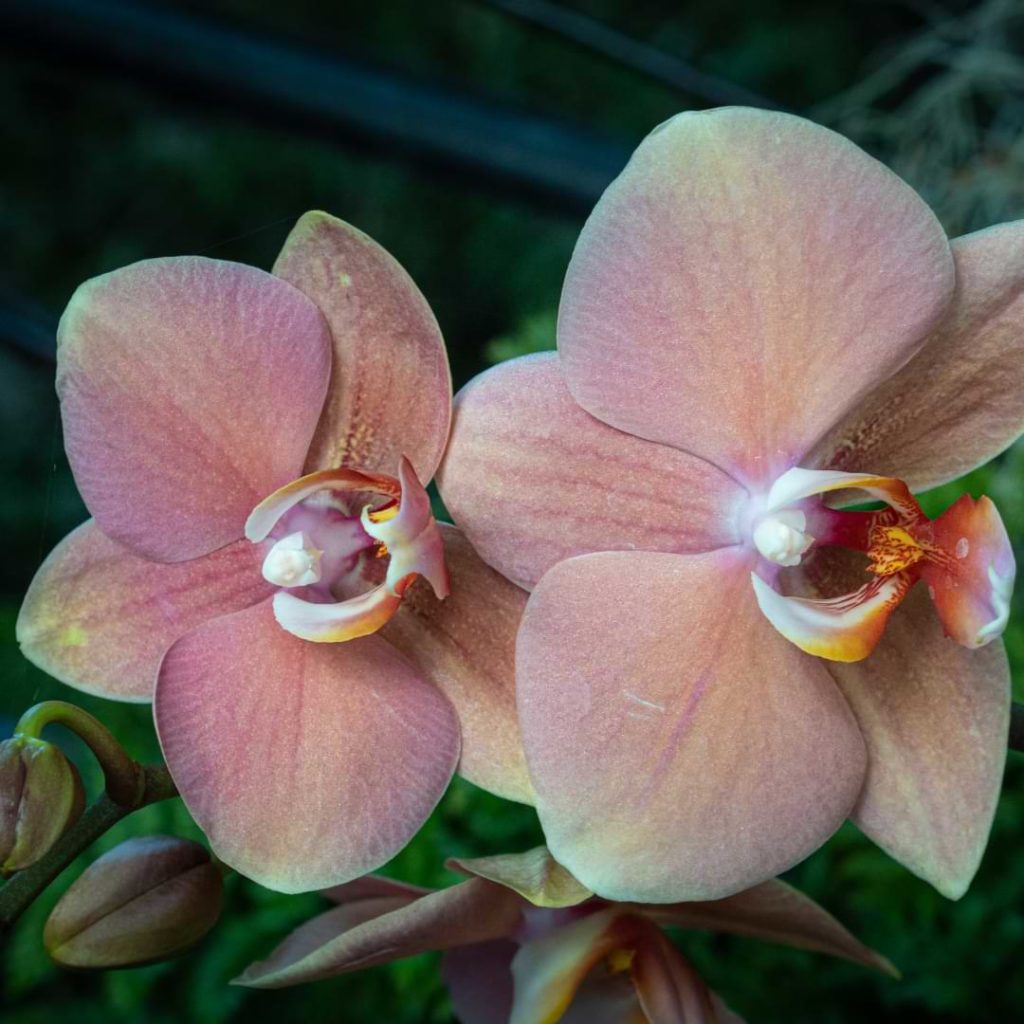Phalaenopsis sanderiana, also known as Sander’s Phalaenopsis, originated in the Philippines. It produces cascading flowers that give it a classic look. This orchid variety is frequently crossed with other phalaenopsis to produce hybrids. In fact, if you find an unnamed phalaenopsis at a big-box store or garden center, it is likely to be a Phal. sanderiana hybrid.
Phalaenopsis are such popular houseplant orchids because they are relatively easy to care for, and phal. sanderiana lives up to its genus.
Phal. sanderiana and its hybrids are perfect for those new to orchids, and for those with a large collection, it’s worth checking out Phal. sanderiana hybrids to find new orchids that will stand out from what you already have.
How to Grow Phalaenopsis Sanderiana
Of course, even though phalaenopsis are easy to care for, they do have some particular requirements in order to grow and flower. Keep reading to find out more about Phalaenopsis sanderiana and how to best care for them.
Light
Most phalaenopsis orchids prefer lower levels of sunlight, but that is not the case for Phalaenopsis sanderiana. This orchid can handle higher levels of sunlight. Phal. sanderiana can stand up to direct sunlight in the morning and afternoon; however, you’ll want to shield your plant from direct noon sunlight, especially during hot summer days.
If your orchids are getting too much sunlight, the leaves will begin to turn yellow or red. If they are not getting enough sunlight, then you may notice the leaves turning a darker green than normal. Watch for signs and adjust positioning as needed.
An orchid that is receiving enough light will have leaves that are a medium- to light-green color.
Temperature & Humidity
Phal. sanderiana is native to the Philippines and is used to growing in a moderately hot, humid environment. They prefer a minimum nighttime temperature of 60-65 degrees Fahrenheit and temperatures between 75-85 degrees Fahrenheit during the day.
During the winter months, phal. sanderiana can handle down to about 50 degrees Fahrenheit for a period of time. Small fluxations are not usually harmful to these orchids.
Like most orchids, Phalaenopsis sanderiana like more humidity than most homes provide. They like environments with between 60% to 80% humidity. You are unlikely to constantly keep your home at these levels because, while this level of humidity is ideal for Phal. sanderiana, it is less than ideal for you and your possessions. Consider placing a humidity tray with water beneath your orchids to raise humidity levels near your orchids without affecting the rest of your house. Occasional use of a humidifier can also help if you live in a particularly dry climate.
How Much Water Does Phalaenopsis Sanderiana Need?
If you have houseplants, you’re probably already aware that your watering schedule can vary greatly depending on a variety of factors. You usually have to water more in the summer than in the winter, and the position of a plant, the type of container it’s in, and the growing medium all play a role in the amount of water needed.
Plan to water Phal. sanderiana about once a week during the summer and adjust as needed. Make sure that the growing medium is allowed to dry out between waterings, and do not keep the plant in a container that does not allow for drainage of excess water.
Most people find that Phal. sanderiana requires more water than other phalaenopsis orchids, so if you already have other phalaenopsis, you can expect to water this orchid a little more often. During the summer, try lightly misting it each morning. This can help add the extra moisture that it needs.
Avoid misting your orchids in the afternoon because you want the water to evaporate before the evening. Otherwise, you may have issues with crown rot. Don’t let this scare you, though; a few drops of water remaining on your orchids every now and then is not likely to cause problems. You can always place a fan near your orchids to help with airflow if necessary.
Orchid Soil
In the wild, most orchids are found happily growing in trees, and Phal. sanderiana is no exception. For this reason, orchids do not do well in normal houseplant potting soil. Instead, they need potting soil that is specifically made for orchids.
Choose a bark mix, moss, or a commercial mix made for orchids. These will allow water to drain properly and keep your orchid from developing root rot.
See also: The Best Soil for Orchids Plus Our Favorite Go-to Potting Mix
Fertilizer
Because orchids grown indoors are not able to access the same nutrients that they would if they were growing in their natural environment, a gentle fertilizer can help them thrive.
You should choose a balanced fertilizer for your orchids. A balanced fertilizer is one where the nitrogen, phosphorus, and potassium (also known as the NPK levels) are the same for each element. For example, an NPK of 20-20-20 or 15-15-15 is a balanced fertilizer.
Select a diluted fertilizer that allows you to control the amount of fertilizer that you are applying. Try an option like Premium Orchid Food. You can use it each time that you water, and you do not run the risk of applying too much and causing damage to your orchids.
Phalaenopsis Sanderiana Flowers
This orchid produces the type of flowers that are classically associated with orchids: large quantities (15-20) of pendant cascading flowers. Phal. sanderiana is commonly used to create many hybrid varieties due to its flowers’ desirable traits.
For a true Phalaenopsis sanderiana, expect white, pink, or purple 3-inch flowers that last for months. Unlike most phalaenopsis, Phal. sanderiana blooms in the off-season in mid to late summer.
Varieties
Thanks to its showy flowers, Phal. sanderiana is frequently crossed to make attractive hybrids. Some of these hybrids are unnamed, and it is not uncommon to run across a hybrid Phal. sanderiana when buying unmarked orchids.
Purple Surprise: A gorgeous cross between sanderiana and bellina, as the name implies, this hybrid has purple flowers, usually with a diamond texture, as well as beautiful silver leaves.
Nicole Dream: Nicole Dream is a particularly eye-catching cross between sanderiana and fuscata. It is a great option for adding unusual colors and patterns to your collection.
Common Problems With Phalaenopsis Orchids
Phalaenopsis orchids are one of the most common orchids sold as houseplants. They are considered an easy orchid to care for because they will grow and flower out of their natural environment as long as some effort is made to mimic natural conditions.
Despite being considered an “easy” orchid, phalaenopsis do sometimes have some problems. Here are a few of the most common issues that come up and how to deal with them.
Problem #1: Root rot
Orchids are tropical plants, so you would assume that they need lots of water. They do need a moderate amount of water, but they need any excess water to drain quickly.
Sitting in pooling water causes an orchid’s roots to rot. Root rot is the most common disease that orchids experience, but it is completely preventable.
What are the signs of root rot in orchids?
If you notice your phalaenopsis dropping buds unexpectedly or leaves that are soft and listless, check the roots. Soft, black roots indicate root rot. Overwatering that causes root rot can kill orchids in a matter of weeks if it continues unchecked.
If there are still some firm, green roots left, then you can still save the plant. Cut back on watering, and make sure that the growing medium drains water well and is allowed to dry out between waterings.
Problem #2: Crown rot
Another problem with rot. You might have heard that you should never allow your orchid’s leaves or crown to get wet out of fear of rot. While it isn’t true that you can never get the crown wet (after all, plants in the wild get rained on all the time), crown rot can occur due to excess moisture without enough air circulation.
How can you tell if your orchids have crown rot?
If you notice discoloration among the leaves near the base of your orchid, crown rot might be the problem. Be sure that water is not pooling up at the base of your orchid. Try to water and mist your orchids in the morning rather than at night when the sunlight will help things dry out faster.
Adding a fan near your orchids can also help as well. After all, in their natural environment, orchids are exposed to more airflow than they are when they are planted in pots.
Try to solve the problem at soon as you see the first signs. Once the leaves turn black, the chance that you will be able to save your orchid is small.
Problem #3: Mealybugs and other pests
Mealybugs, scale, and mites are annoying pests that can be problematic for your orchids.
Mealybugs are small, light-colored, and are mostly found on the underside of leaves. If you notice mealybugs, immediately isolate that plant from the rest of your collection. Neem oil, horticultural oil, or insecticides can help you deal with a light to moderate infestation. Mealybugs are mobile and able to hide in the growing medium, so it is worth switching out the old growing medium for a clean one.
Spider mites are another common issue with orchids. While you probably won’t be able to see the mites, you’ll notice that the underside of your orchid’s leaves looks silver due to loss of sap. Wiping your plant down with rubbing alcohol can kill these pests. To prevent mites in the first place, try misting your orchids regularly. Spider mites thrive in hot, dry environments.
Scale, a potentially serious problem for orchids, can be difficult to get rid of, and any plant affected by scale should be isolated immediately to prevent spreading. Rubbing alcohol and neem oil can help cut down on the pests once they are identified. Unfortunately, the most effective way to get rid of scale is by using insecticides, but most insecticides that are best at eradicating scale also tend to be too toxic to use inside the home.
Phalaenopsis Sanderiana Plant Care FAQ
FAQ: Why is my Phalaenopsis sanderiana not blooming?
If you notice that your Phalaenopsis sanderiana does not seem to be blooming when you expect it to, first know that Phal. sanderiana’s bloom schedule is somewhat different from most phalaenopsis. Rather than blooming in the winter or spring, Phal. sanderiana usually blooms in mid to late summer.
If it is the correct time for Phal. sanderiana to bloom but you are not seeing anything, then there may be a problem. Make sure that your orchids are getting enough sunlight. Phal. sanderiana can handle some direct light in the morning and afternoon, so make sure that you are giving it the light it needs. Dark-green leaves indicate a lack of light.
Next, check the root system. Make sure that you have not been overwatering and preventing your roots from getting access to oxygen. A healthy root system allows your orchids to bloom, while an unhealthy root system will not be able to store enough energy to bloom.
Join Our Orchid Care Facebook Community
In our Facebook group of orchid lovers, we’re dedicated to creating a rich and engaging environment where plant lovers can come together and share tips, tricks, and experiences.
If you’re an orchid lover, come join our Facebook community! We can’t wait to celebrate your successes and help you troubleshoot your care routine.
For continued success, you can explore our other articles or visit our online shop for plant care products that are sure to keep your plants boasting rich green leaves and big, bountiful blooms year-round.
More Great Orchid Resources



